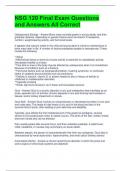NSG 120 Final Exam Questions
and Answers All Correct
Osteoporosis Etiology - Answer-Bone mass normally peaks in young adults, and then
gradually declines, depending on genetic factors (such as vitamin D receptors),
nutrition, weight-bearing activity, and hormonal levels.
It appears that calcium intake in the child and young adult is critical to maintenance of
bone mass later in life. A number of factors predispose people to osteoporosis. These
include the following:
**Aging
**Mechanical stress on bone by muscle activity is essential for osteoblastic activity;
Decreased mobility is a factor
**One limb or area of the body may be affected by osteoporosis when it is immobilized
because of conditions such as a fracture
**Hormonal factors such as hyperparathyroidism, Cushing syndrome, or continued
intake of catabolic glucocorticoids such as prednisone
**Deficits of calcium, vitamin D, or protein related to diet or history of deficits in
childhood or malabsorption disorders
**Cigarette smoking
**Small, light bone structure, as in Asian and Caucasian persons
Gout - Answer-Gout is a chronic disorder of uric acid metabolism that manifests as an
acute, episodic form of arthritis; chronic deposits of uric acid forming hard nodules in
tissues; and/or kidney impairment or stones.
Gout S&S - Answer-Gout involves an overproduction or decreased excretion of uric acid
and urate salts. This leads to high levels of uric acid in the blood and also in the
synovial fluid of joints, often leading to joint deformity and disability.
Typically, gout affects the first metatarsal joint of the great toe (podagra), causing
severe to excruciating pain when an attack occurs. The joints of the feet, ankles, knees,
and even hands also can be affected.
Pain usually peaks after several hours, and then subsides gradually. A slight fever,
chills, headache, or nausea may accompany an acute attack.
Between attacks, the person is characteristically free from any symptoms. Gout also is
characterized by renal dysfunction, hyperuricemia, and renal calculi (kidney stones)
rheumatoid arthritis - Answer-a chronic autoimmune disorder in which the joints and
some organs of other body systems are attacked\
,Rheumatoid arthritis is considered an autoimmune disorder, the exact nature of the
abnormality has not been fully determined.
A genetic factor is present, with familial predisposition. The abnormality seems to be
linked to several viral infections.
Rheumatoid factor is not present in all patients with rheumatoid arthritis, yet it may be
present in certain other disorders as well.
Rheumatoid arthritis is more common in women than men, and the incidence increases
with aging.
Rheumatoid Arthritis S&S - Answer-**insidious at onset, often becoming manifest as
mild general aching and stiffness.
**Inflammation may be apparent first in the fingers or wrists. It affects joints in a
symmetric (bilateral) fashion, and usually more than one pair of joints is involved.
**The joints appear red and swollen and often are sensitive to touch as well as painful.
**Joint stiffness occurs following rest, which then eases with mild activity as circulation
through the joint improves.
**Joint movement is impaired by the swelling and pain. **Daily activities become
difficult, including dressing, food preparation, and oral hygiene.
**Malocclusion of the teeth may develop from TMJ involvement as the condyle is
damaged.
Systemic signs are marked during exacerbations and include fatigue, anorexia, mild
fever, generalized lymphadenopathy, and generalized aching.
With each exacerbation of disease, the function of the affected joints is further impaired
as joint damage progresses. Eventually the joint is no longer inflamed but is fixed and
deformed ("burned out").
Osteoarthritis Etiology - Answer-The primary form of osteoarthritis is associated with
obesity and aging, whereas the secondary type follows injury or abuse.
Osteoarthritis often develops in specific joints because of injury or excessive wear and
tear on a joint. This is a common consequence of participation in sports and certain
occupations.
Once the cartilage is damaged, joint alignment or the frictionless surface of the articular
cartilage is lost.
OA S&S - Answer-*The pain of osteoarthritis, which is often mild and insidious initially,
is an aching that occurs with weight bearing and movement.
, *Joint movement is limited. Frequently the joint appears enlarged and hard as
osteophytes develop.
*Walking becomes difficult if joint is immobile
*Crepitus may be heard as the cartilages become irregular, grating against each other.
*Osteoarthritis is not a systemic disorder; therefore there are no systemic signs or
changes in serum levels.
Ankylosing Spondylitis Etiology - Answer-A chronic progressive inflammatory condition
that affects the sacroiliac joints, intervertebral spaces, and costovertebral joints of the
axial skeleton.
Women tend to have peripheral joint involvement to a greater extent than men, although
the disorder is more common in men.
It usually develops in persons 20 to 30 years of age and varies in severity.
Remissions and exacerbations mark the course. The cause has not been fully
determined, but it is deemed an autoimmune disorder with a genetic basis, given the
presence of HLA-B27 antigen in the serum of most patients.
Ankylosing Spondylitis S&S - Answer-*initial low back pain and stiffness
*Rigid spine
*Some systemic signs (fever, fatigue, weight loss)
*Uveitis, particularly iritis (inflammation in the eye)
Lymes Etiology - Answer-Lyme disease is an infectious disease caused by the
spirochete bacterium. Ticks that bite the skin spread Lyme disease by injecting the
bacterium from their gut into the human body when securing a blood meal. Lyme
disease can affect the skin, joints, heart, and nervous system.
Lymes S&S - Answer-Approximately half of all patients with Lyme disease have a
characteristic red, itchy rash with a red circle center resembling the bull's eye on a
target.
Lyme disease can masquerade as arthritis and cause influenza-like symptoms, such as
headache, fever, fatigue, joint pain, and general malaise.
late complications of muscle weakness, paralysis, and neurologic conditions (e.g.,
learning difficulties, excessive fatigue, and muscle coordination problems) can develop.
Diabetes Type I - Answer-*early, abrupt onset usually before 30 years of age
*Little or no insulin being secreted by patient
*Can be difficult to control




